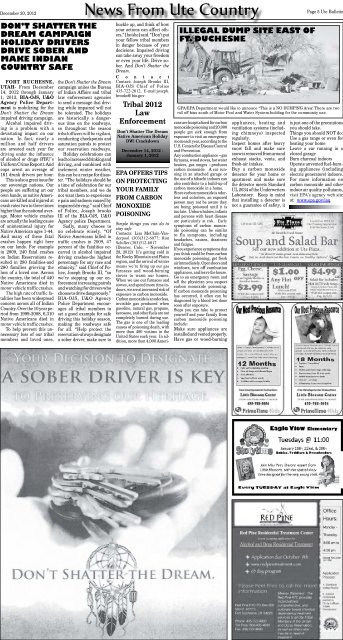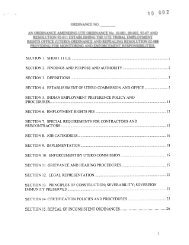You also want an ePaper? Increase the reach of your titles
YUMPU automatically turns print PDFs into web optimized ePapers that Google loves.
December 20, 2012<br />
Don’t Shatter the<br />
Dream Campaign<br />
holiDay DriverS<br />
Drive Sober anD<br />
make inDian<br />
Country Safe<br />
FORT RUCHESNE,<br />
UTAH- From December<br />
14, 2012 through January<br />
1, 2013, BIA-OJS, U&O<br />
Agency Police Department<br />
is mobilizing for the<br />
Don’t Shatter the Dream<br />
impaired driving campaign.<br />
Alcohol impaired driving<br />
is a problem with a<br />
devastating impact on our<br />
nation. In fact, nearly a<br />
million and half drivers<br />
are arrested each year for<br />
driving under the influence<br />
of alcohol or drugs (FBU’s<br />
Uniform Crime Report). And<br />
cops arrest an average of<br />
161 drunk drivers per hour.<br />
This is also a great issue for<br />
our sovereign nations. Our<br />
people are suffering art our<br />
own hands, as native Americans<br />
are killed and injured at<br />
crash rates two to three times<br />
higher than the national average.<br />
Motor vehicle crashes<br />
are actually the leading cause<br />
of unintentional injury for<br />
Native American ages 1-44.<br />
And many of these fatal<br />
crashes happen right here<br />
on our lands. For example<br />
in 2009, 240 fatal crashes<br />
on Indian Reservations resulted<br />
in 280 fatalities-and<br />
280 families grieving the<br />
loss of a loved one. Across<br />
the country, the total of 440<br />
Native Americans died in<br />
motor vehicle traffic crashes.<br />
The high rate of traffic fatalities<br />
has been widespread<br />
concern across all of Indian<br />
Country. Over the 10 year period<br />
from 1999-2008, 6,310<br />
Native Americans died in<br />
motor vehicle traffic crashes.<br />
To help prevent this unnecessary<br />
loss of our tribal<br />
members and loved ones,<br />
News From <strong>Ute</strong> Country<br />
the Don’t Shatter the Dream<br />
campaign unites the Bureau<br />
of Indian Affairs and tribal<br />
law enforcement agencies<br />
to send a message that driving<br />
while impaired will not<br />
be tolerated. The holidays<br />
are historically a dangerous<br />
time on the roadways,<br />
so throughout the season<br />
tribal officers will be vigilant,<br />
conducting checkpoints and<br />
saturation patrols to protect<br />
our reservation roadways.<br />
Holiday celebrations can<br />
lead to increased drinking and<br />
driving, and combined with<br />
inclement winter weather,<br />
this can be a recipe for disaster.<br />
“The holidays should be<br />
a time of celebration for our<br />
tribal members, and we do<br />
not want them to experience<br />
e pain and sadness caused by<br />
impaired driving.” said Chief<br />
of Police, Joseph brooks<br />
III of the BIA-OJS, U&O<br />
Agency police Department.<br />
Sadly, many choose to<br />
no celebrate wisely. “Of<br />
Native Americans killed in<br />
traffic crashes in 2009, 47<br />
percent of the fatalities occurred<br />
in alcohol impaired<br />
driving crashes-the highest<br />
percentage for any race and<br />
ethnicity,” said Chief of Police,<br />
Joseph Brooks III, “so<br />
we’re stepping up our enforcement<br />
increasing patrols<br />
and watching for drivers who<br />
choose to drive dangerously.”<br />
BIA-OJS, U&O Agency<br />
Police Department encourages<br />
all tribal members to<br />
set a good example for safe<br />
driving this holiday season,<br />
making the roadways safe<br />
for all. “Help protect the<br />
reservation-always designate<br />
a sober driver, make sure to<br />
buckle up, and think of how<br />
your actions can affect others,”<br />
[he/she] said. “Don’t put<br />
your fellow tribal members<br />
in danger because of your<br />
decisions. Impaired driving<br />
can take away your freedom<br />
or even your life. Drive sober.<br />
And Don’t Shatter the<br />
Dream.<br />
C o n t a c t<br />
Contact: Joseph Brooks III,<br />
BIA-OJS Chief of Police<br />
435-722-2012, E-mail:joseph.<br />
brooks@bia.gov<br />
Tribal 2012<br />
Law<br />
Enforcement<br />
Don’t Shatter The Dream<br />
Native American Holiday<br />
DWI Crackdown<br />
December 14, 2012 -<br />
January 1, 2012<br />
EPA OFFERS TIPS<br />
ON PROTECTINg<br />
yOUR FAmIly<br />
FROm CARBON<br />
mONOxIDE<br />
POISONINg<br />
Simple things you can do to<br />
stay safe<br />
Contacts: Lisa McClain-Vanderpool<br />
(303)312-6077; Ron<br />
Schiller (303)312-6017<br />
(Denver, Colo. – November<br />
28, 2012) It’s getting cold in<br />
the Rocky Mountain and Plains<br />
region, and the arrival of winter<br />
means we’re firing up our gas<br />
furnaces and wood-burning<br />
stoves to warm our homes.<br />
When we use our furnaces and<br />
stoves, and spend more time indoors,<br />
we are at increased risk of<br />
exposure to carbon monoxide.<br />
Carbon monoxide is an odorless,<br />
invisible gas produced when<br />
gasoline, natural gas, propane,<br />
kerosene, and other fuels are not<br />
completely burned during use.<br />
The gas is one of the leading<br />
causes of poisoning death, with<br />
more than 400 victims in the<br />
United States each year. In addition,<br />
more than 4,000 Ameri-<br />
illegal Dump Site eaSt of<br />
ft. DuCheSne<br />
Page 5 <strong>Ute</strong> Bulletin<br />
GPA/EPA Department would like to annouce “This is a NO DUMPING Area! There are two<br />
roll off bins south of Motor Pool and Water System building for the community use.<br />
cans are hospitalized for carbon<br />
monoxide poisoning and 20,000<br />
people get sick enough from<br />
exposure to visit an emergency<br />
room each year, according to the<br />
U.S. Centers for Disease Control<br />
and Prevention.<br />
Any combustion appliance --gas<br />
furnaces, wood stoves, hot water<br />
heaters, gas ranges --produces<br />
carbon monoxide. A car running<br />
in an attached garage or<br />
the use of a hibachi indoors can<br />
also contribute to a build-up of<br />
carbon monoxide in a home.<br />
Since carbon monoxide is odorless<br />
and colorless, an exposed<br />
person may not be aware they<br />
are being poisoned until it is<br />
too late. Unborn babies, infants<br />
and persons with heart disease<br />
are particularly at risk. Early<br />
symptoms of carbon monoxide<br />
poisoning can be similar<br />
to flu symptoms, including<br />
headaches, nausea, dizziness<br />
and fatigue.<br />
If you experience symptoms that<br />
you think could be from carbon<br />
monoxide poisoning, get fresh<br />
air immediately. Open doors and<br />
windows, turn off combustion<br />
appliances, and leave the house.<br />
Go to an emergency room and<br />
tell the physician you suspect<br />
carbon monoxide poisoning.<br />
If carbon monoxide poisoning<br />
has occurred, it often can be<br />
diagnosed by a blood test done<br />
soon after exposure.<br />
Steps you can take to protect<br />
yourself and your family from<br />
carbon monoxide poisoning<br />
include:<br />
Make sure appliances are<br />
installed and vented properly.<br />
Have gas or wood-burning<br />
appliances, heating and<br />
ventilation systems (including<br />
chimneys) inspected<br />
regularly.<br />
Inspect homes after heavy<br />
snow fall and make sure<br />
snow is removed from around<br />
exhaust stacks, vents, and<br />
fresh-air intakes.<br />
Buy a carbon monoxide<br />
detector for your home or<br />
apartment and make sure<br />
the detector meets Standard<br />
UL 2034 of the Underwriters<br />
Laboratory. Keep in mind<br />
that installing a detector is<br />
not a guarantee of safety, it<br />
is just one of the precautions<br />
you should take.<br />
Things you should NOT do:<br />
Use a gas range or oven for<br />
heating your home<br />
Leave a car running in a<br />
closed garage<br />
Burn charcoal indoors<br />
Operate unvented fuel-burning<br />
appliances (including<br />
electric generators) indoors.<br />
For more information on<br />
carbon monoxide and other<br />
indoor air quality pollutants,<br />
visit EPA’s agency web site<br />
at: www.epa.gov/iaq.



